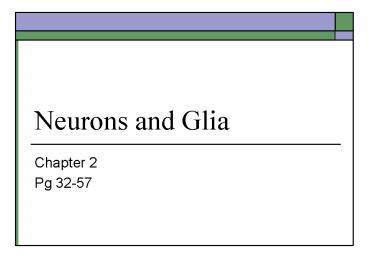Neurons and Glia - PowerPoint PPT Presentation
1 / 18
Title:
Neurons and Glia
Description:
Neurons and Glia Chapter 2 Pg 32-57 Obstacles to Study Cells are too small to see. To study brain tissue with a microscope, thin slices are needed but the brain is ... – PowerPoint PPT presentation
Number of Views:58
Avg rating:3.0/5.0
Title: Neurons and Glia
1
Neurons and Glia
- Chapter 2
- Pg 32-57
2
Obstacles to Study
- Cells are too small to see.
- To study brain tissue with a microscope, thin
slices are needed but the brain is like jello. - Formaldehyde used to fix or harden tissue early
in 19th century. - Brain tissue is all the same color
- Nissl stain revealed cell bodies
cytoarchitecture - Golgi stain revealed parts of the neuron.
3
Golgi stain shows cell structure
4
Brodmann Areas
- Different areas of the brain with different
functions have different kinds of neurons. - Brodmann mapped the areas based on the kinds of
cells found - Cytoarchitectonic method
- 52 functionally distinct areas identified by
number.
5
Ramon y Cajals Principles
- Neuron doctrine neurons are like other cells.
- Principle of dynamic polarization electrical
signals flow in only one, predictable direction
within the neuron. - Principle of connectional specificity
- Neurons are not connected to each other, but are
separated by a small gap (synaptic cleft). - Neurons communicate with specific other neurons
in organized networks not randomly.
6
Neuronal Circuits
- Neurons send and receive messages.
- Neurons are linked in pathways called circuits
- The brain consists of a few basic patterns of
circuits with many minor variations. - Circuits can connect a few to 10,000 neurons.
7
Parts of the Neuron
- Soma the cell body
- Neurites two kinds of extensions (processes)
from the cell - Axon
- Dendrites
- All parts of the cell are made up of protein
molecules of different kinds.
8
How Neurons Communicate
- An all-or-nothing electrical signal, called an
action potential, travels down the axon. - The amplitude (size) of the action potential
stays constant because the signal is regenerated. - The speed of the action potential is determined
by the size of the axon. - Action potentials are highly stereotyped (very
similar) throughout the brain. - At the end of the axon (terminal button),
neurotransmitter is released, which may start an
action potential in another neuron.
9
The Synapse
- The synapse is the point of contact between
neurons. - Axon terminal button makes contact with some part
of an adjacent neuron. - Synaptic vesicles containing neurotransmitter
open when there is an action potential. - Neurotransmitter may enter the adjacent neuron
unused neurotransmitter is reabsorbed (reuptake).
10
Dendrites
- Dendrites function as the antennae of the neuron,
receiving input from other neurons. - Dendrites are covered with synapses.
- Each synapse has many receptors for
neurotransmitters of various kinds. - Dendritic spines specialized dendrites that
isolate reactions at some synapses.
11
Dendritic Spines
12
How to Tell Axons from Dendrites
- Dendrites receive signals axons send them.
- There are hundreds of dendrites but usually just
one axon. - Axons can be very long (gt 1 m) while dendrites
are lt 2 mm. - Axons have the same diameter the entire length
dendrites taper. - Axons have terminals (synapses) and no ribosomes.
Dendrites have spines (punching bags). - Dont be fooled by the branches both have them.
13
Ways of Classifying Neurons
- By the number of neurites (processes)
- Unipolar, bipolar, multipolar
- By the type of dendrites
- Pyramidal stellate (star-shaped)
- By their connections (function)
- Sensory, motor, relay interneurons, local
interneurons (Golgi Type II neurons) - By neurotransmitter by their chemistry
14
Parts of the Soma (Cell Body)
- Nucleus stores genes of the cell (DNA)
- Organelles synthesize the proteins of the cell
- Cytosol fluid inside cell
- Plasmic membrane wall of the cell separating it
from the fluid outside the cell.
15
Organelles
- Mitochondria provide energy
- Microtubules give the cell structure
- Rough endoplasmic reticulum produces proteins
needed to carry out cell functioning - Ribosomes produce neurotransmitter proteins
- Smooth endoplasmic reticulum packages
neurotransmitter in synaptic vesicles - Golgi apparatus Part of the smooth endoplasmic
reticulum that sorts proteins for delivery to the
axon and dendrites
16
Kinds of Cells
- Neurons (nerve cells) signaling units
- Glia (glial cells) supporting elements.
- Miscellaneous other cells
- Ependymal cells form the lining of the
ventricles, also aid brain development - Microglia remove debris left by dead or
degenerating neurons and glia. - Veins, arteries, and capillaries in the brain.
17
Functions of Glia
- Separate and insulate groups of neurons
- Produce myelin for the axons of neurons
- Scavengers, removing debris after injury
- Buffer and maintain potassium ion concentrations
- Guide migration of neurons during development
- Create blood-brain barrier, nourish neurons
18
Kinds of Glia
- Oligodendrocytes surround brain spinal cord
neurons and give them support. - In white matter, provides myelination
- In gray matter, surround cell bodies
- Schwann cells provide the myelin sheath for
peripheral neurons (1 mm long). - Astrocytes absorb potassium, perhaps nutritive
because endfeet contact capillaries (blood
vessels), form blood-brain barrier.































